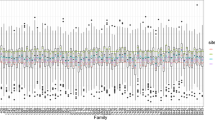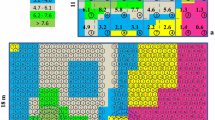Summary
The efficiency of the honeycomb selection procedure in selecting outstanding genotypes was observed at two interplant distances (d), i.e. d=100 cm, low density, representing noncompetitive conditions and d=15 cm, high density, representing presence of interplant competition. Progress due to selection among the plants grown with and without competition was established by comparison of the plot performance of offspring from selected plants with that of offspring from plants taken at random. The relation between selection intensity and response to selection was observed to detect a possible negative correlation between competing and yielding ability.
So far, the results obtained do not yet allow to make a choice between selection of individual plants in presence or in absence of interplant competition. No significant correlation between single plant yield and plot yield was found at any of the two densities. However, response to selection for yield was higher when selecting at low density supporting Fasoulas' preference for selecting single plants in absence of competition. These results must be taken with caution since seed quality and a biassed sample of random plants exerted an important effect on the obtained response to selection.
Similar content being viewed by others
References
Bell, G.D.H., 1963. Breeding techniques-general techniques. In: Barley Genetics I. Proc. 1st Barley Genet. Symp. Wageningen, Holland, pp. 285–302.
Bos, I., 1981. The relative efficiency of honeycomb selection and other procedures for mass selection in winterrye (Secale cereale L.). Dept. of Plant Breeding, Agric. Univ., Wageningen. pp. 172.
Bos, I., 1983. Some remarks on honeycomb selection. Euphytica 32: 329–335.
Chebib, F.S., S.B. Helgason & P.J. Kaltsikes, 1973. Effect of variation in plant spacing, seed size and genotype on plant-to-plant variability in wheat. Z. Pflanzenzüchtg. 69: 301–332.
Fasoulas, A.C. 1973. A new approach to breeding superior yielding varieties. Publ. 3. Arist. Univ., Thessaloniki. pp. 42.
Fasoulas, A.C., 1981. Principles and methods of plant breeding. Publ. 11. Arist. Univ., Thessaloniki. pp. 147.
Fasoulas, A., 1988. The honeycomb methodology of plant breeding. Dept. of Genetics and Plant Breeding. Arist. Univ., Thessaloniki pp. 167.
Fasoulas, A. & A. Tsaftaris, 1975. An integrated approach to plant breeding and field experimentation. Publ. 5. Arist. Univ., Thessaloniki. pp. 37.
Hamblin, J., R. Knight & M.J. Atkinson, 1978. The influence of systematic micro-environmental variation on individual plant yield within selection plots. Euphytica 27: 497–503.
Hanson, P.R., G. Jenkins & B. Westcott, 1979. Early generation selection in a cross of spring barley. Z. Pflanzenzüchtg. 83: 64–80.
Knight, R., 1983. Some factors causing variation in the yield of individual plants of wheat. Aust. J. Agric. Res. 34: 219–228.
Knott, D.R., 1972. Effects of selection for F2 plant yield on subsequent generation in wheat. Can. J. Plant Sci. 52: 721–726.
Kyriakou, D.T. & A.C. Fasoulas, 1985. Effects of competition and selection pressure on yield response in winterrye (Secale cereale L.). Euphytica 36: 883–895.
Lulsdorf, M.M. & P.B.E. McVetty, 1986. Comparison of honeycomb and independent culling of spaced plants for yield potential in faba bean. Can. J. Plant Sci. 66: 483–489.
Lungu, D.M., P.J. Kaltsikes & E.N. Larter, 1987. Honeycomb selection for yield in early generations of spring wheat. Euphytica 36: 831–839.
McGinnis, R.C. & L.H. Shebeski, 1968. The reliability of single plant selection for yield in F2. In: K.W. Finlay (Ed.), Proc. 3rd Intern. Wheat Genet. Symp., Canberra, Australia, pp.410–415.
Mitchell, J.W., R.H. Baker & D.R. Knott, 1982. Evaluation of honeycomb selection for single plant yield in durum wheat. Crop Sci. 22: 840–843.
Nass, H.G. 1978. Comparison of selection efficiency for grain yield in two population densities of four spring wheat crosses. Crop Sci. 18: 10–12.
Niehaus, W.S. 1981. Effectiveness of harvest index and the honeycomb design in early generation yield evaluation in durum wheat. PhD Thesis, North Dakota State Univ.
Onenanyoli, A.H.A. & A.C. Fasoulas 1989. Yield response to honeycomb selection in maize. Euphytica 40: 43–48.
Robertson, L.D. & K.J. Frey, 1987. Honeycomb design for selection among homozygous oat lines. Crop Sci. 27: 1105–1108.
Sneep, J., 1977. Selection for yield in early generations of self-fertilizing crops. Euphytica 26: 27–30.
Spitters, C.J.T., 1979. Competition and its consequences for selection in barley breeding. Agric. Res. Rep. 893, Wageningen. pp. 268.
Stam, P., 1984. Estimation of genotypic values without replication in field trials. Euphytica 33: 841–852.
Valentine, J., 1979. The effect of competition and method of sowing on the efficiency of single plant selection for grain yield, yield components and other characters in spring barley. Z. Planzenzüchtg. 83: 193–204.
Author information
Authors and Affiliations
Rights and permissions
About this article
Cite this article
Pasini, R.J., Bos, I. The effect of interplant distance on the effectiveness of honeycomb selection. I. Results of the first selection cycle. Euphytica 49, 121–130 (1990). https://doi.org/10.1007/BF00027261
Received:
Accepted:
Issue Date:
DOI: https://doi.org/10.1007/BF00027261




